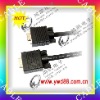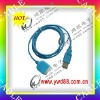Detailed Product Description
1.ETHERNET CABLE
2.NETWORK CABLE
3.PATCH CORD
4.RJ45 CABLE ROHS UL CERTIFICATED
5.OD 5.0mm 24AWG VERIFIED TO TIA/EIA-568-B.2
Category 5 cable, is a high signal integrity cable type often referred to as Cat5. Most cables are unshielded relying on the twisted pair design for , and some are . Category 5 has been superseded by the Category 5e specification for such as , and is also used to carry many other signals such as basic services, , and (at up to 155 /s, over short distances).
Category 5
The specification for category 5 cable was defined in /, with clarification in TSB-95. These documents specified performance characteristics and test requirements for of up to 100 MHz.
Category 5 cable includes in a single cable jacket. This use of helps preserve a high signal-to-noise ratio despite interference from both external sources and other pairs (this latter form of interference is called ). It is most commonly used for 100 Mbit/s networks, such as 100BASE-TX , although defines standards for 1000BASE-T - over category 5 cable. Cat 5 cable typically has three twists per inch of each twisted pair of 24 copper wires within the cables.
Category 5e
Cat 5e cable is an enhanced version of Cat 5 that adds specifications for . It was formally defined in 2001 as the standard, which no longer recognizes the original Cat 5 specification. Although was designed for use with Cat 5 cable, the tighter specifications associated with Cat 5e cable and connectors make it an excellent choice for use with 1000BASE-T. Despite the stricter performance specifications, Cat 5e cable does not enable longer cable distances for Ethernet networks: cables are still limited to a maximum of 100 m (328 ft) in length (normal practice is to limit fixed ("horizontal") cables to 90 m to allow for up to 5 m of patch cable at each end, this comes to a total of the previous mentioned 100m maximum). Cat 5e cable performance characteristics and test methods are defined in TIA/EIA-568-B.2-2001.
Offshore Low End Cable Problem
The Communications Cable and Connectivity Association, Inc.(CCCA) cautioned that many offshore-manufactured communications cable products could present significant fire risk. In response to concerns from the industry, the CCCA commissioned an independent laboratory to analyze whether nine randomly selected offshore samples of these products met U.S. minimum requirements for performance and safety. Test results showed that none of the samples fully met all of the minimum requirements and eight of the nine samples failed to meet the National Fire Protection Association (NFPA) minimum code requirements for low flame spread and/or smoke safety requirements for installation in commercial buildings, schools and multi-tenant residences. Many of the samples failed the flame spread and smoke tests catastrophically. Because of the seriousness of these safety concerns, the CCCA plans to work in cooperation with the major leading independent telecommunications industry testing agencies to establish a new product certification program. Although details of the proposed program have not yet been established, a key component will be independent laboratory testing of structured cabling products that have been procured from pointof-sale locations..
Copper clad Aluminum
The American market had also been flooded with copper clad cable imported mostly from China and falsely presenting itself on the market as being a 100% copper Cat 5e cable. With less copper involved in the manufacturing process cost to the consumer is priced lower while lying to the consumer and not getting a true 100% copper Cat 5e cable.
Installation of copper clad aluminum Cat 5e wire has also been proven by low voltage contractors in the Southern California market where this cable first arrived to have poor test results and often not passing the Category 5e standard. Being that copper conducts electricity better than aluminum, signal strength has also been proven to be very weak over long cable runs.
Offshore manufactures have also falsely presenting Cat 5e cable conductors as being 24 gauge. In actuality a 26 gauge conductor has been sold and is very hard to notice unless further examination under the sheath of the conductor is reviewed. A 26 gauge Cat 5e cable will not make proper contact on Cat 5e jack modules as most jack modules are 22 or 24 gauge required.
The United States Federal Government will not accept bids from China made Cat 5e cable due to China being absent from the Trade Agreement Act of 1979. In general, a product is "TAA compliant" if it's made in the United States or a "Designated Country."
Connectors and other information
The cable exists in both stranded and solid conductor forms. The stranded form is more flexible and withstands more bending without breaking and is suited for reliable connections with , but makes unreliable connections in . The solid form is less expensive and makes reliable connections into insulation displacement connectors, but makes unreliable connections in insulation piercing connectors. Taking these things into account, building wiring (for example, the wiring inside the wall that connects a wall socket to a central patch panel) is solid core, while patch cables (for example, the movable cable that plugs into the wall socket on one end and a computer on the other) are stranded. Outer insulation is typically or .
Cable types, connector types and cabling topologies are defined by . Nearly always, , often incorrectly referred to as "", are used for connecting category 5 cable. The specific category of cable in use can be identified by the printing on the side of the cable.
The cable is terminated in either the T568A scheme or the T568B scheme. Canada uses the T568A standard and the United States commonly uses T568B. It really doesn't make any difference which is used as long as you use only one of the standards so all connections are the same at your location to avoid confusion and potential problems. Mixed cable types should not be connected in series as the impedance per pair differs slightly and may cause signal degradation. The article describes how the cable is used for Ethernet, including special .









